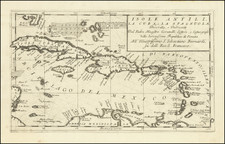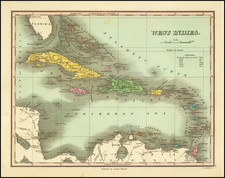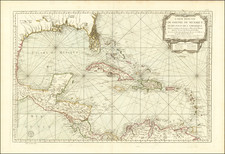This captivating double-page map of the island of Jamaica, divided by parishes, was published in Augsburg by Matthäus Seutter in the mid-18th century. One of the most ornate maps of Jamaica to appear in a commercial atlas of the time, its cartouche presents a vivid depiction of enslaved people harvesting, processing, and curing sugar cane. In the background, sea turtles and a mermaid observe the activities.
The map portrays the significance of the English Colony of Jamaica during the mid-18th century. It includes detailed topographical features and depth measurements for southern harbors, amongst other intricate details. The upper-right-hand corner features an extensive note in German, which provides additional context and information about the island.
Descriptive Text
The text describes Jamaica as an island of the Mexican Archipelago in the northern sea of North America, located to the south of Cuba and to the west of Dominica. Notably, Christopher Columbus was said to have given the island the name 'Jacobi,' from which 'Jamaica' originated, during his first voyage there at the end of the 15th century. At that time, it was under Spanish control until the English took over in 1654.
The island is approximately 170 English miles from east to west and 70 miles from south to north, with an estimated circumference of 350,000 steps. Jamaica's soil is fertile, and its former inhabitants were expelled by the Spanish. The English divided the island into 12 regions or dioceses, including St. Andrew, St. Anna, St. Catherine, St. David, St. Elizabeth, St. George, St. Jacob, St. John, St. Maria, St. Thomas of Clarendon, Port Royal, and Uthamede.
The island is primarily populated along its northern coast, with its principal cities being St. Jacob, Port Royal, Port Lana, Port Marant, and Sevilla. In the middle, a high ridge of mountains stretches from east to west. Abundant springs and rivers flow across the land, providing significant benefits to the inhabitants and the soil.
The northern soil is black and clayey, while the southern soil is red and sandy, but both are fertile. The island produces a variety of lush trees and abundant fruits. Fields and meadows are found in the middle of forests and mountain crevices, which makes for good livestock farming. The island's climate is perpetually temperate and healthy (!), with rains occurring in May and November. The land yields excellent sugar, ginger, indigo dye, and an abundance of cocoa. Various medicinal herbs, like Aloe, China root, Sarsaparilla, Tamarinds, and Anise, also grow there.
The island benefits from convenient ports, the most important being Fort Royal, closely followed by Maranta port in the province of St. Thomas. The inhabitants of these twelve provinces total around 6000, in addition to 3000 sailors. The island's laws are in agreement with those of England, and various magistrates and courts can be found there.
Matthäus Seutter (1678-1757) was a prominent German mapmaker in the mid-eighteenth century. Initially apprenticed to a brewer, he trained as an engraver under Johann Baptist Homann in Nuremburg before setting up shop in his native Augsburg. In 1727 he was granted the title Imperial Geographer. His most famous work is Atlas Novus Sive Tabulae Geographicae, published in two volumes ca. 1730, although the majority of his maps are based on earlier work by other cartographers like the Homanns, Delisles, and de Fer.
Alternative spellings: Matthias Seutter, Mathaus Seutter, Matthaeus Seutter, Mattheus Seutter











![Culiacanae, Americae Regionis, Descriptio [with] Hispaniolae, Cubae, Aliarumqe Insualrum Circumiacientium Delineatio](https://storage.googleapis.com/raremaps/img/small/86114.jpg)


![[War of Jenkins Ear in Florida and West Indies] [Harbors, Towns & Fortresses of North America, St. Augustine, Providence (Grand Bahama Island), Porto Antonio (Jamaica), Havana, Santiago (Cuba), Kingston, and Antiqua)]](https://storage.googleapis.com/raremaps/img/small/75642.jpg)